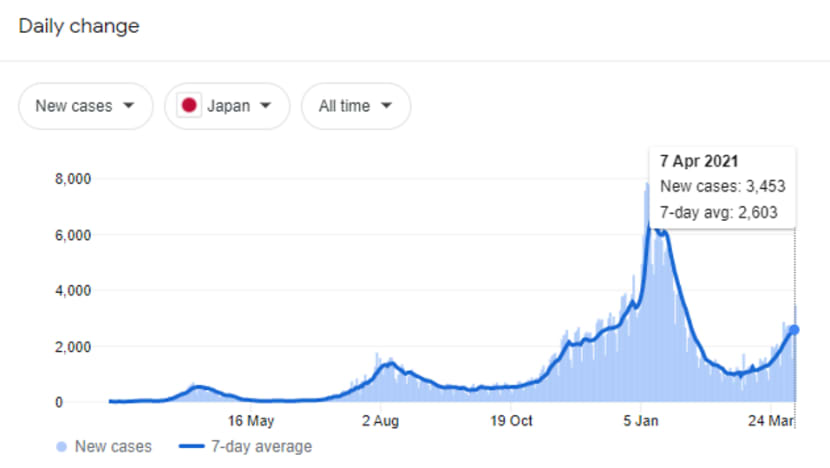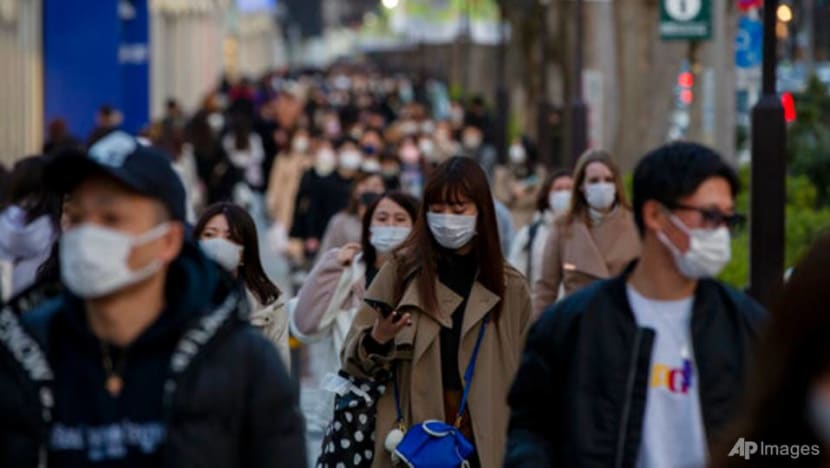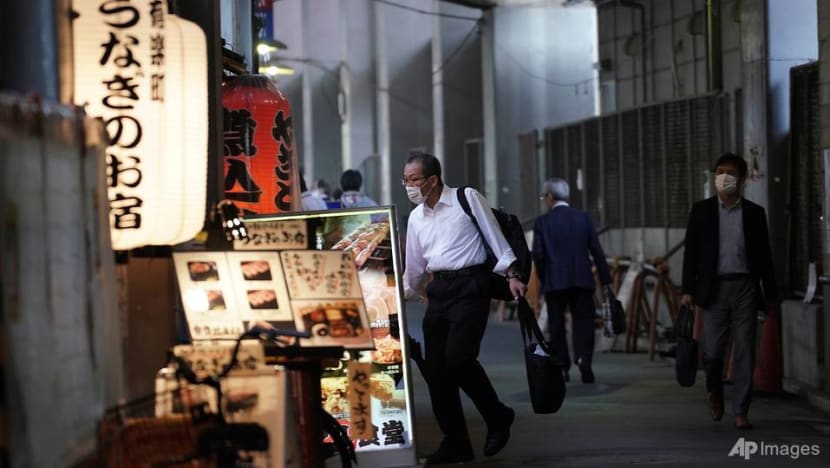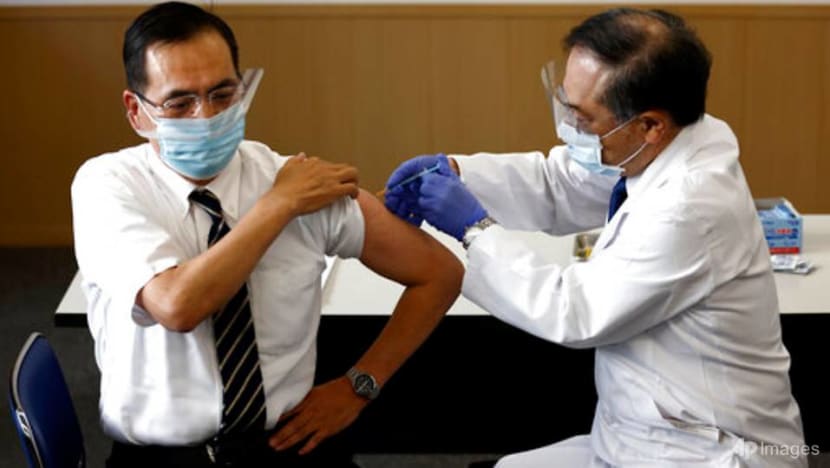commentary Commentary
Commentary: Japan’s slow-mo vaccination programme has a lot riding on it
With few mandatory restrictions, and national leaders focused on holding the Tokyo Olympics, vaccination should be a top priority and even that has been very slow, says Yuka Hasegawa.

Screengrab of COVID-19 cases in Japan. (Source: Google)
OSAKA: For all the talk about how orderly, societally conscious and efficient Japan is, the country should be a shining example of how to get the coronavirus under control but remains a cautionary tale in the pandemic a year on.
Just look at the endless waves of coronavirus plaguing it, including record-breaking new infection numbers reached just this past week, with 878 new cases in Osaka on Wednesday (Apr 7) and a positive test rate of 8.6 per cent, causing the prefecture to declare a state of medical emergency on the same day. Even Tokyo with its shocking 555 looks better off.
Hospital resources are coming under strain with 90.8 per cent of Osaka’s ICU in use, and constraints on medical staff numbers limiting opening up more beds.
READ: Commentary: Japan really needs to get cracking on coronavirus testing
SOFT MEASURES
Osaka city officials have been described as prescient when “quasi-emergency measures” went into effect just two days ago on Apr 5 in Osaka. Restaurants and bars had to close earlier by 8pm, with fines for non-compliance. Authorities too urged residents to stay home and refrain from heading out on Wednesday.
But the problem is these bear striking resemblance to conditions imposed during the State of Emergency, which have been widely acknowledged to be toothless in the face of a raging pandemic. Here, you could be pardoned for asking what restrictions were imposed under threat of law enforcement, because precisely there were few.
To be fair, the atmosphere of fear and uncertainty then did see most citizens staying home, avoiding all contact with others.
READ: Commentary: Japan has taken care of two COVID-19 waves so how bad can this third one be?
Thanks to the courage and resilience of the Japanese people, infection numbers today have climbed down from a high moving 7-day average of 6,446 cases a day in January to 2,603 today.
However, little of this success can be attributed to its leaders. Looking at Japan’s daily cases since the start of the pandemic, there have been three peaks, each much higher than the other, with the current trend an uphill surge. This is not one roller-coaster you want to get on.

Why has this been the case? For a start, even though people do wear masks, rules mandating mask-wearing does not exist in Japan.
If that sounds ludicrous, consider how much ruckus Osaka governor Hirofumi Yoshimura and Osaka city mayor Ichiro Matsui’s idea of enforcing ”mask dining”, requiring diners to unstrap one side of a mask or pull down the mask to their chin while eating and mask up when not eating, has received.
Businesses say they are at a loss at ensuring compliance, never mind that such rules are common place in other countries, including Singapore, since last year when the practice became mandatory in exchange for F&B outlets being allowed to open in the first place.
Requiring plastic separators to be installed is not rocket science either but seems to have gathered confusion as if it is.
READ: Commentary: Why Japan’s move to close schools during COVID-19 outbreak upset many – and not just parents
This strong pushback from business shows little wonder Japanese politicians remain skittish about taking bolder action to safeguard public health where these impact their corporate stakeholders.
But the problems go deeper, suggesting bureaucratic sluggishness and a fundamental lack of urgency. Take another example: A programme called the “patrol group”, which mirrors Singapore’s Safe Distancing Ambassadors programme, and sees pairs of government employees check for compliance in restaurants, was supposed to check all 40,000 restaurants by May 5, but such inspections only began on Monday.

Stronger measures and stricter rules are needed but people think Japan has ridden COVID-19 out. The barriers could be cultural. There is a strong sense of caution in Japan about the government restricting private rights since World War II.
Conscious of public opinion, the administration has been reluctant to take coercive measures. This is why the Japanese government has so far resorted to "self-restraint" as the main approach to battle a deadly pandemic.
But denial of the spiraling situation is rife, never mind that there is a highly contagious strand on the loose. Among the 341 new cases in Osaka on Monday, 270 involved the new UK variant. More than half of those tested in Hyogo and Osaka on average have tested positive for the UK strain.
READ: Commentary: Japan shows how not to deal with a COVID-19 outbreak
AN EYE ON TOKYO OLYMPICS
You would think a changeover of leadership might add more urgency to the nation’s fight against COVID-19 or at least spark new thinking.
But despite rolling 7-day average figures surpassing levels from the first two waves, Prime Minister Yoshihide Suga surprised a House of Councilors committee meeting by saying that COVID-19 cases have not reached a nationwide fourth wave, even as he urged extra vigilance.
His hesitance over raising the alarm on Japan’s coronavirus cases is understandable. Having painted himself into a corner by publicly framing the holding of the Tokyo Olympics as “proof that humanity has defeated the pandemic”, Mr Suga know his back is to the wall.

But his position to press on does not have full support from the international community.
A Japan Press Research Institute survey released in March shows 70 per cent of Japanese surveyed say the summer games and paralympics should be cancelled or further postponed. When respondents from the US, China, France, South Korea and Thailand were polled by the same institute, a similar 70 per cent expressed the same sentiment.
Having already held the torch relay just days after Tokyo lifted its state of emergency, Japanese leaders might feel they cannot turn back. And so authorities have taken great pains to pare down risks and avoid accepting international spectators but are leaving Olympics sporting events open for the general Japanese public to attend.
READ: Commentary: Organisers may have little choice than to cancel the Tokyo Olympics
SLOW VACCINATION
You would think therefore that Japan should get swiftly into action to vaccinate the 126 million local population but the country has been on the back foot on securing enough vials to get shots in arms.
Thus, vaccination in Japan started pretty late on Feb 17, more than two months after many other major countries like the US and UK began. Mass vaccination beyond the country’s 4.7 million healthcare workers will only begin from Apr 12. Most seniors will only be seeing their first shots in May after a 100 million doses of Pfizer doses are delivered.

According to the Ministry of Health, Labour and Welfare, only 1.4 million vaccinations have been completed. According to Our World in Data, Japan's vaccination rate is the lowest in OECD countries, which includes 37 major industrialised countries, at 0.79 per cent.
This rate could stay stubbornly low when only certified doctors and nurses are allowed to administer the shots.
Indeed, Japan is a modern, technologically savvy country, except when it comes to the coronavirus. The government's contact confirmation app, COCOA, was expected to curb the spread of the disease, but incompatibility with Android phones went unnoticed for four months.
A year has passed since Japan first declared a State of Emergency due to the pandemic. In the meantime, more than 480,000 people have been infected, and more than 9,000 people have died.
Much has been said about the grotesque mismanagement of the coronavirus by the US and UK governments, but these pale in comparison to Japan, which continues to flounder even with a new Prime Minister.
Yuka Hasegawa is a researcher who writes on social issues and politics in Japan.










